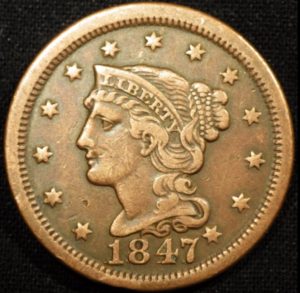Braided Hair Cents
The public wasn’t always so kind to the large cent design. Criticism has been hurled its way since it first appeared in 1793 to last design in the series, the Braided Hair Cent. It was criticism that prompted another redesign of the large cent – the last – and this time Chief Engraver Christian Gobrecht decided to give Liberty a much more youthful appearance.
History of the Braided Hair Cent
Benjamin West was an Anglo-American painter who specialized in historical, religious, and mythological subjects. One of his works in the early 19th century, Omnia Vincit Amor (Love triumphs over everything), depicts Venus (goddess of love) and her small son, Amor. It is the figure of Venus that is believed to have been Gobrecht’s influence in the design of the Braided Hair coin.
The version of Liberty in the 1839 large cent design has braided hair over her brow, a coronet, and long, loose locks – reflecting a popular Empire style that had gone out of fashion in Europe but still very much popular in America.
Early Braided Hair Cents, those released from 1839 to 1843, feature a younger-looking Liberty. She is depicted in the obverse with head turned upright and a graceful pose. The figure is surrounded by thirteen stars with the date placed below.
The reverse side of the coin still featured a closed-circle laurel wreath. The single-stemmed wreath shows leaves grouped in four with alternating berries between them. The words ONE CENT is placed within the wreath while the words UNITED STATES OF AMERICA circles the edge of the coin.
In 1843, Gobrecht used a bold serif-style font for the words in the reverse side of the coin. The change made the letters look bigger than previous releases.
The Braided Hair large cent was produced from 1839 to 1857, when it was discontinued. The 1843 Braided Hair design prevailed until the production of the coin ceased.
It made one final appearance in 1868 when Mint Director Henry Linderman wanted “fantasy pieces” made using old dies. Copper and nickel were used to create the 1868 Braided Hair coin and only fewer than a dozen are known to exist.
Collecting the Braided Hair Cent
Technological changes allowed greater uniformity in the minting of Braided Hair Cents. However, some varieties exist since minor changes were introduced to the coin until 1843. The Red Book or Naked Eye varieties are an example. They feature large and small dates for versions produced in 1840 and 1842, as well as different obverse and reverse combinations for the 1843 edition.
Other minor varieties have been identified in coins released in 1844, 1846, 1847, 1851, and 1855.
The arrival of steam power in 1836 resulted in an increased production of Braided Hair large cents. The Philadelphia Mint produced between 1.5 million to 9 million pieces each year, except for 1857.
Braided Hair proofs exist for all production dates except 1839, 1851, and 1853, but they are rare.
The end of Braided Hair large cents came with the introduction of the 19mm Flying Eagle cents. Although it wasn’t sorely missed when it ceased production in 1857, it was quite popular among collectors, years after.
